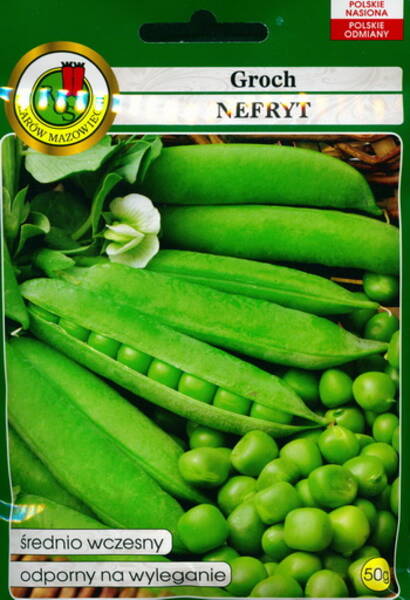Early-maturing (45-50 days) shelling variety. The plant is medium-sized, moderately leafy, 45-55 cm long. Pod is 6-8 cm long, 6-8-seeded. Seeds are round-angular, light green, medium-sized, with good taste qualities. Pea yield is 0.3-0.5 kg/m2.
Value of the variety: early maturity, uniform formation and ripening of beans, resistance to lodging, suitability for single harvesting. Recommended for fresh consumption, canning, freezing and drying.
1.0 g = 4-8 seeds.
Requirements: peas can grow in any climatic conditions and any soil, provided that it is loose and sufficiently supplied with humus. Avoid places that are too sheltered from the wind.
Sowing: The first in the year — as early as mid-April — you can sow shelling peas. It is able to tolerate light frosts even when in bloom. In April, marrowfat and sugar peas are sown. In principle, you can sow later — in mid-June, but it is not recommended to do this, because then, in the case of a hot summer, the harvest will be meager. The distance between rows of peas is 40 cm, if the rows are double — 10 cm. The interval between plants in a row is 5 cm. After laying the seeds to a depth of 5 cm, cover them and press them firmly into the ground.
Fertilization: the need for nutrients in peas is small, so well-rotted compost is usually quite enough. You should completely abandon nitrogen-containing fertilizers, since the plants themselves produce nitrogen. In view of this, the roots of plants after harvesting must be left in the ground.
Care: soon after germination, the rows of peas should be hilled. Usually, peas need support in order to make harvesting easier. Bush peas can do without support, but can also grow on a wire mesh. The soil should always be properly moistened. Its drying out leads to a decrease in the volume of the harvest.
Harvesting: shelling peas are the first to ripen. It must be picked as soon as possible, before it loses its green color. Marrowfat peas must be harvested young, as it is not suitable for drying. It begins to be harvested in mid-June, like sugar peas, which, however, can remain on the plant for a long time without compromising quality.
Biological protection: birds are happy to peck at peas, so the sowing must be covered. Aphids are easily removed from the leaves with water. Powdery mildew appears mainly as a result of overcrowding of plants. Remove affected plants immediately.












